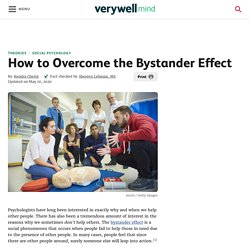

Video: What is the Bystander Effect? Article: What Is the Bystander Effect? If you witnessed an emergency happening right before your eyes, you would certainly take some sort of action to help the person in trouble, right?

While we might all like to believe that this is true, psychologists suggest that whether or not you intervene might depend upon the number of other witnesses present. What Is the Bystander Effect? The term bystander effect refers to the phenomenon in which the greater the number of people present, the less likely people are to help a person in distress.
When an emergency situation occurs, observers are more likely to take action if there are few or no other witnesses. Being part of a large crowd makes it so no single person has to take responsibility for an action (or inaction). In a series of classic studies, researchers Bibb Latané and John Darley found that the amount of time it takes the participant to take action and seek help varies depending on how many other observers are in the room. Image: Diffusion of Responsibility. Image: Pluralistic Ignorance. Video: The Death of Kitty Genovese. Article: Death of Raymond Zack. On Memorial Day, 2011, 53-year-old Raymond Zack, of Alameda, California, walked into the waters off Robert Crown Memorial Beach and stood neck deep in water roughly 150 yards offshore for almost an hour.

His foster mother, Dolores Berry, called 9-1-1 and said that he couldn't swim and was trying to drown himself.[1] There are conflicting reports about Zack's intentions.[2] City of Alameda firefighters and police responded but did not enter the water. The firefighters called for a United States Coast Guard boat to respond to the scene. The boat the Coast Guard sent drafted too deep for the shallow water off the beach. No boat ever arrived.[1] According to police reports, Alameda police expected the firefighters to enter the water.[3] Firefighters later said that they did not have current training and certifications to perform land-based water rescue, and that funding for the program was cut.
[edit] Members of the local community were outraged. [edit] Family impact[edit] Documentary[edit] Article: Richmond High School Gang Rape. The incident received national attention.[4][5] As many as 20 witnesses are believed to have been aware of the attack, but for more than two hours no one notified the police.[6] The trials for the six defendants began September 2012, with defendant Manuel Ortega pleading guilty to four felonies and sentenced the following month to 32 years in prison.

Ari Morales was sentenced to 27 years in prison. Jose Montano and Marceles Peter were convicted of forcible rape acting in concert, a forcible act of sexual penetration while acting in concert, and forcible oral copulation in concert.[7] Details[edit] On October 24, 2009 at about 9:30 p.m. A bystander described the assault: They were kicking her in her head and they were beating her up, robbing her and ripping her clothes off; it's something you can't get out your mind. Witnesses are believed to have recorded video footage of the attack using camera-equipped mobile phones, but local police have not been able to obtain the recordings. Video: Experiment on The Bystander Effect. PDF: Young Children Show The Bystander Effect. PDF: Personality Does Predict the Bystander Effect. PDF: Gender and Helping Behavior. Image: Active Bystander Tips.
Article: How to Overcome the Bystander Effect. Psychologists have long been interested in exactly why and when we help other people.

There has also been a tremendous amount of interest in the reasons why we sometimes don't help others. The bystander effect is a social phenomenon that occurs when people fail to help those in need due to the presence of other people. In many cases, people feel that since there are other people around, surely someone else will leap into action.1 While the bystander effect can have a negative impact on prosocial behavior, altruism and heroism, researchers have identified a number of different factors that can help people overcome this tendency and increase the likelihood that they will engage in helping behaviors.2 Some of these include: Witnessing Helping Behavior Sometimes just seeing other people doing something kind or helpful makes us more willing to help others.
Imagine that you are walking into a large department store. Being Observant Being Skilled and Knowledgeable Guilt Feeling Good. Video: What is an Upstander? Video: Be an Upstander.